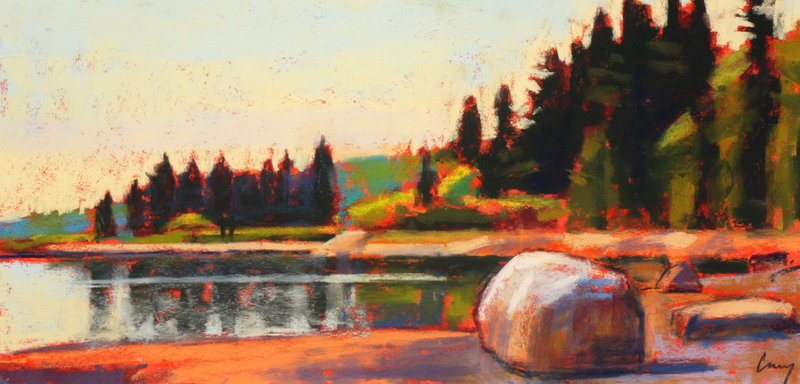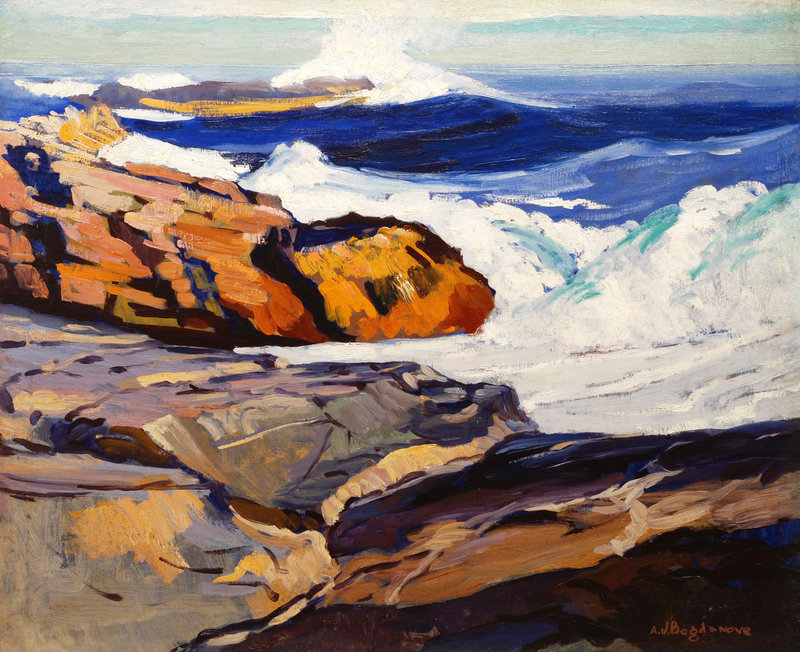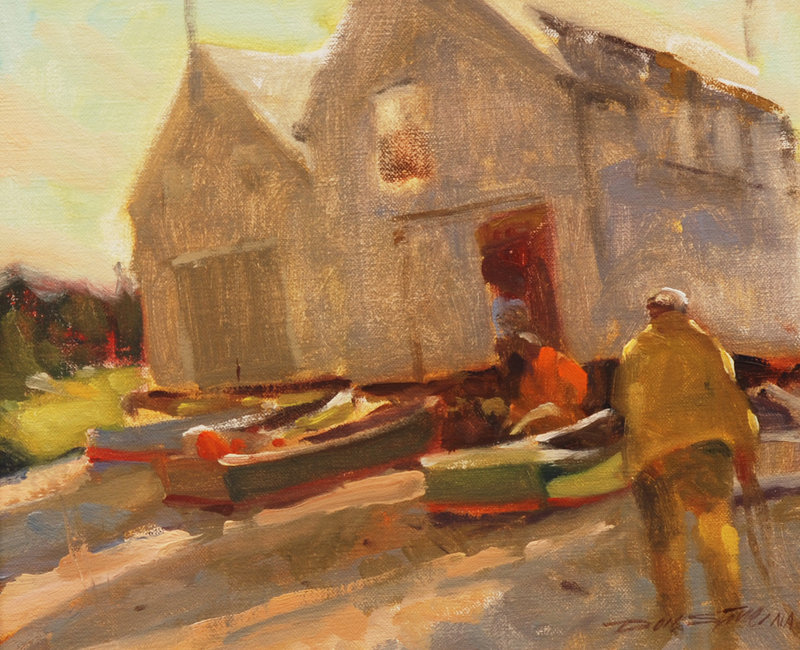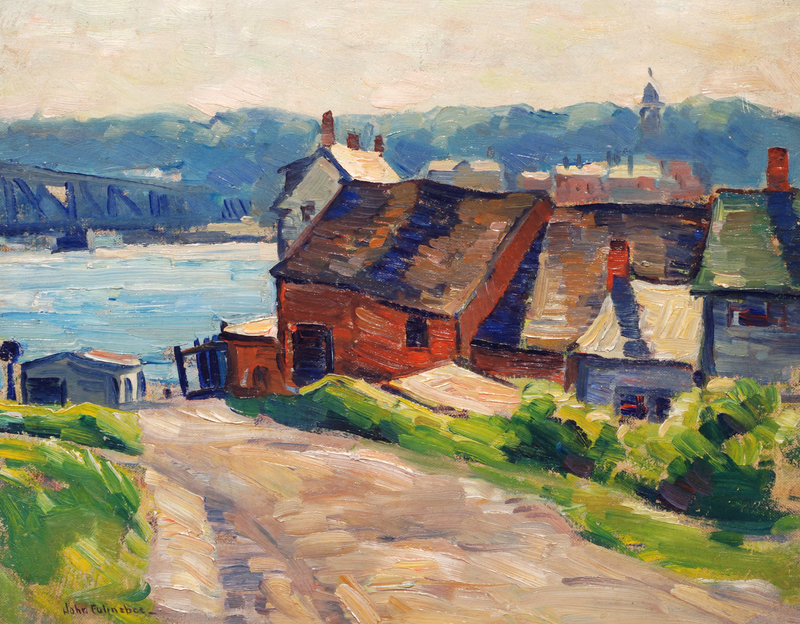The Wiscasset Bay Gallery is an old-school art gallery. The bulk of the work is inventory owned by the gallery, and the walls are hung salon-style so that at least 100 paintings are on view.
The exhibition “Across the Pond and Back: 19th & 20th Century American & European Paintings,” would seem to leapfrog from “Learning to Paint: American Artists and European Art, 1876-1893,” which just closed at the Bowdoin College Museum of Art last month.
But in reality, this is less of a curated exhibition than an excuse to showcase a broad range of work.
I see shows like “Across the Pond and Back” as simple exercises in shuffling a gallery’s inventory with an eye to shifting around the featured works. I have no problem with that. dint of their not being soaked in some airtight conceptual context, it’s probably easier to see works of art for their own self-possessed qualities.
Wiscasset Bay Gallery’s front room now features works by the dozen or so active artists they represent. Oddly, the gallery calls these their “contemporary” artists, yet their work is conservative and would never be mistaken for contemporary art. It’s a mixed group in terms of quality, but it features some very strong artists.
My favorite of the “contemporary” works includes a small but handsome canvas by the well-known Don Stone. “Beach Work” shows an older man watching a fisherman pull a dory up onto a beach in front of a shed.
The way the shadows point toward the beach hints that this is the end of a long day — even though the warm light feels more like the basking glow of a Maine morning. Stone’s facile brushwork ranges from the light touch of a wash to luscious, even creamy, highlights.
Tom Curry’s pastels reveal a masterful and strategic color sense. He lays cool pigments over saturated hot tones. His “Stillness,” a coastal forest scene, shimmers with life and visual excitement. Curry handles pastel energetically and with a confident physical sense of the material.
In a room with dozens of paintings, I tend to be drawn to the ones I think are the strongest while ignoring the weaker ones. Because of that, I usually enjoy densely hung shows. If you aren’t like that, “Across the Pond and Back” might not be your cup of tea.
I saw pieces I didn’t like and a few that didn’t seem to rise to the level of the gallery, but all in all, it is a worthy group of paintings.
I was particularly enamored with Abraham Bogdanove’s Monhegan seascapes. His “Cobalt Seas” creates an unusual and deeply compelling concave space in which a rolling wave has sucked back the waters lapping the rocky shore.
The palette is rich and contrasty: the sea shifts from deep blues to flashing whites and foaming teal. The rocks flow — in creamy caramel and chocolate auburn — just as effortlessly as the frothing sea.
As “Cobalt Seas” reveals Bogdanove’s virtuosity with the brush, “The Wave” is a master lesson in how to paint with the palette knife. Rather than riding the stroke of the wet brush, the artist here sculpts rhythm, edge and volume. The result is that the motion and mass of the waves dynamically overwhelm the staid and almost-drowning rocks. “The Wave” is a brilliant, elegant and beautiful painting.
“Monhegan Cliffs (Shore Patrol)” is a terrific James Fitzgerald watercolor — clear, bold and accessible. Yet something is odd: the solidly tough figure seen from the back seems to be in colonial garb like a character from a Kenneth Roberts novel. It’s unusual — but very cool.
I was also impressed by a pair of works by John Fulton Folinsbee, particularly a Van Gogh-esque scene of the bridge between Woolwich and Bath painted in the 1930s.
I completely enjoyed an early 19th-century painting by the Englishman George Webster, “Fishing Vessels with a Dutch Man-O-War.”
It is a storm-tossed coastal scene with several smaller vessels and the warship in alarming proximity to the bulwarked shore. But compared to the furiously majestic power of the Maine school’s seas, Webster’s wispily roiling waters seem hardly the stuff of nature’s angry wrath.
“Across the Pond and Back” is hardly a coherent exhibition, but it’s more than enough of an excuse to check out Wiscasset Bay Gallery.
Freelance writer Daniel Kany is an art historian who lives in Cumberland. He can be contacted at:
dankany@gmail.com
Send questions/comments to the editors.






Success. Please wait for the page to reload. If the page does not reload within 5 seconds, please refresh the page.
Enter your email and password to access comments.
Hi, to comment on stories you must . This profile is in addition to your subscription and website login.
Already have a commenting profile? .
Invalid username/password.
Please check your email to confirm and complete your registration.
Only subscribers are eligible to post comments. Please subscribe or login first for digital access. Here’s why.
Use the form below to reset your password. When you've submitted your account email, we will send an email with a reset code.